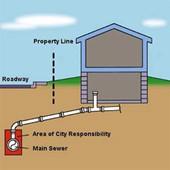Message from Cedarburg Water Recycling Center

We all use an abundance of clean water everyday but what happens to that water after you flush a toilet or wash your hands? Most homes consist of drains which are connected to a plumbing system within the house. Plumbing systems are connected to what is called a “lateral” which is designed to connect the house or building plumbing to the sanitary sewer main. The City of Cedarburg is responsible for everything in the sanitary sewer main (red Box) while the property owner is responsible for their private lateral all the way up to the point of connection with the sanitary sewer main. Once the dirty water enters the sewer system it is considered wastewater. Sewer mains are designed to flow by gravity to help the wastewater make its way to the wastewater treatment facility. The wastewater is then treated properly and discharged into Cedar Creek as clean water. Any additional information can be found on the City of Cedarburg’s website under the Wastewater Department page.
The Wastewater staff would like to remind homeowners that it is illegal to hook up their sump pump discharge pipe to the city’s sewer system. While this may seem like an easy solution, it causes several problems in the sewer system. It’s possible for raw sewage to back up in basements causing damage to personal property. Additionally, when we receive this abundance of rainwater in spring time, the Wastewater Plant becomes over loaded and we can’t achieve the same level of treatment as we would otherwise. So please do your part in protecting our sewer system and have your sump pump discharge in your yards rather than into the city’s sanitary sewer.
An additional requirement for the Wastewater Treatment Plant discharge is chloride reduction. High concentrations of chlorides (salt) can negatively affect aquatic life and receiving water bodies therefore we want to limit it as much as possible. The best way to do that is stopping it at its source. Residential water softeners are the largest contributor of chlorides to the Wastewater Treatment Plant. On demand water softeners use just as much salt as needed to treat your hard water instead of based on time. The rule of thumb is that if your water softener is 14 years old or older, it should be replaced because it has lost its efficiency over time. This will be a cost savings to the homeowner as well because “on demand” water softeners require less salt usage.

